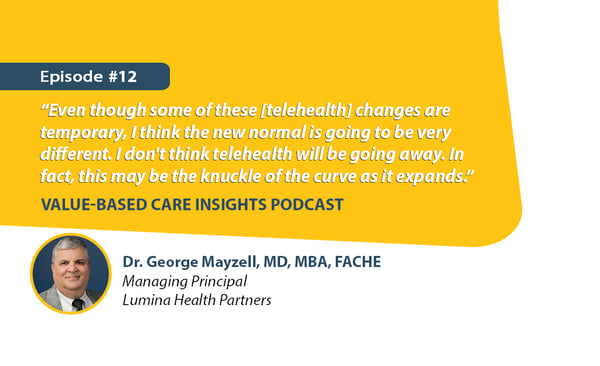Episode Overview:
The current COVID-19 pandemic is putting new pressures on healthcare infrastructure and providers, challenging them to meet increasing patient care demands while maintaining the safety of staff, patients, and even entire communities.
As a result, providers are being called on to pivot their care delivery models and leverage technology, providing patient care at a distance while meeting the health and safety needs of the community.
In this two-part series, Daniel J. Marino and Shaillee Chopra first revisit Lumina’s “Patient Care in Crisis: How to Launch, Code and Bill Telehealth Services” webinar to review Dr. George Mayzell’s insights on setting up telehealth visits within a practice. Then we’ll hear Lucy Zielinski’s suggestions for documenting and billing for telehealth visits to ensure practices are reimbursed appropriately.
Co-hosts:

Daniel J. Marino, Managing Partner, Lumina Health Partners

Shaillee Chopra, Principal, Lumina Health Partners
Guests:
 Dr. George Mayzell (MD, MBA, FACHE, Managing Principal, Lumina Health Partners
Dr. George Mayzell (MD, MBA, FACHE, Managing Principal, Lumina Health Partners
 Lucy Zielinski, Managing Partner, Lumina Health Partners
Lucy Zielinski, Managing Partner, Lumina Health Partners
Episode Discussion Areas:
1. Key steps to consider as providers adopt and implement telehealth services.
- What are the important elements in creating this virtual visit?
- How can providers make the experience seamless for staff and patients?
- What workflow is required from a clinical and administrative perspective?
2. Clinical and administrative workflows look very different in remote environments.
- The entire staff will take on additional responsibilities to ensure providers deliver appropriate care in a timely manner.
- Providers will experience a learning curve with virtual visits that require a new approach to scheduling and executing appointments.
3. Managing billing for virtual visits.
- Why is appointment type so important?
- What are the appropriate service codes, modifiers and place of service codes?
- What are the four main categories of telemedicine services ?
4. How telehealth affects profitability margins.
- Revenue should stay consistent as in-person office visits during this emergency.
- Office and staffing expenses may decrease, but technology expenses may increase.
- It is possible margins remain steady.

9 Key Takeaways: How to Launch Telehealth Services
- There are five important elements to creating virtual visits through telehealth. To successfully offer virtual visits, providers must:
- Establish visit guidelines — including pre-visit planning
- Implement compatible technology
- Continue entering visit documentation in the EHR and set up unique codes in the practice management system
- Set up the right communication channel
- Think through what needs to happen to schedule the visit, as well as pre-visit, at the visit and post-visit
- Providers need to see the right patients in a telehealth setting.
- Not every case can or should be handled by telehealth (e.g., patients experiencing chest pain or shortness of breath). Not only will providers need to agree on the visit types they’re willing to treat virtually, but they’ll also want to decide how to address patients presenting with COVID-19 symptoms.
- Providers must think through the entire telehealth process before launching virtual visits.
- Before providers can deliver care virtually, they’ll want to create a workflow for the entire visit process. This means deciding what technology platform they’re using for virtual visits (e.g., EMR, Skype, Zoom, FaceTime), what the pre-registration requirements are, how they’ll deliver concrete follow-up instructions to patients, and how they’ll close the loop on billing and orders.
- Telehealth visits differ from traditional in-office visits in several important ways.
- While being unable to conduct a physical exam may be the most obvious difference between virtual and in-person visits, scheduling, workflows, and billing are also very different. With virtual visits, providers must also now evaluate the opportunities and risks of accepting new patients.
- Something as simple as office space makes a big difference in the remote delivery of care.
- Office visits are still office visits, even when performed virtually. Providers will need to be mindful of their office setup, audio and video functionality, WiFi strength, and access to patient portals and telehealth solutions.
- Providers need to create a positive virtual experience for patients.
- In addition to setting up a dedicated, effective professional-looking space, providers must also manage their time and schedules to keep appointments on track. There’s no “waiting room” where patients can be advised that the physician is behind schedule, so it’s vital to build in a large buffer of time between appointments, especially during the learning curve period.
- The administrative workflow needs to complement the clinical workflow.
- As providers make the switch to telehealth, they need to clearly map out the administrative side of the process to support virtual visits, including creating a pre-registration process, and working with commercial carriers to identify billing requirements and levels of reimbursement. Just as important is thoroughly training every staff member who touches this workflow
- Policies and procedures are changing frequently, so providers must keep up.
- There have been several changes to CMS and commercial payer policies and procedures even since the broadened CMS waivers came out at the beginning of March. Providers must ensure they know what services are covered and must be clear with patients about billing procedures and payment expectations.
- Telehealth is here to stay.
- The government has relaxed many of the requirements surrounding telemedicine visits and reimbursement, allowing providers to introduce telehealth to their portfolio of services. As a result, providers can not only manage patients concerned about their exposure to COVID-19, but they can also create new access points for patients to treat current chronic diseases and address current medical issues.
Resources Mentioned
- Insights page of the Lumina website
- “Patient Care in Crisis: How to Launch, Code and Bill Telehealth Services” webinar
About Value-Based Care Insights Podcast
Value-Based Care Insights is a podcast that explores how to optimize the performance of programs to meet the demands of an increasing value-based care payment environment. Hosted by Dan Marino and Shaillee Chopra, the VBCI podcast highlights recognized experts in the field and within Lumina Health Partners.






Share this: